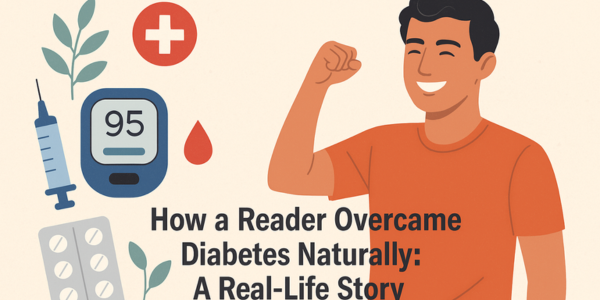A reader shares how he overcame diabetes naturally. His story highlights how lifestyle changes can prevent chronic illness and long-term financial strain.
Usually, the content I share on this blog revolves around personal finance—investments, insurance, retirement planning, and how to achieve financial freedom with discipline. However, today I want to take a slight detour and share something different but equally important. One of my blog readers recently shared his personal journey of living with and managing diabetes. While this is not directly related to finance, I felt it was important and relevant enough to share with all of you.
You may wonder why a financial blog is talking about health. The answer is simple—chronic illnesses like diabetes can silently erode your financial health too. From regular medication to diagnostic tests, lifestyle changes, consultations, and sometimes even alternative therapies, the cost of managing diabetes over the long term can be substantial. It’s a condition that not only requires physical discipline but also demands financial preparedness. Many of us spend years planning for goals like buying a house or saving for retirement, but forget that an unexpected health condition can disrupt everything overnight.
Through this blog reader’s real-life experience, my intention is to highlight not just the power of health discipline, but also to gently remind everyone that staying healthy is in itself a form of financial planning. After all, a sound body often leads to a sound wallet. I hope this story inspires and educates—both from a lifestyle and financial perspective.
How a Reader Overcame Diabetes Naturally: A Real-Life Story

My name is Sunil, and I have been living with Type 2 Diabetes for over 20 years. With the help of regular medication (oral tablets), I’ve usually managed to keep my HbA1c around 6.8. However, I recently decided to explore ways to improve my sugar control further. To do this, I experimented with a Continuous Glucose Monitor (CGM) to understand how my daily food and activities affect my sugar levels. The insights I gained from this journey helped me bring down my HbA1c to 6.2—or even slightly lower.
Food: The Game-Changer in Sugar Control
One of the biggest lessons I learned was this: the type and quantity of food make a massive difference. Since the CGM stays active for 15 days, I tested around 40 different food items to see how each impacted my blood sugar.
Through this experiment, I found that reducing or eliminating carbohydrates had a significant effect on my sugar control. I cut down or avoided all forms of:
- Roti
- Rice-based dishes
- Idli and dosa
- Bread and bakery products
- Biscuits and processed foods
Any ready-to-eat or packaged food usually contains high amounts of sugar or refined flour, which leads to sugar spikes. It’s better to minimize or completely avoid such foods.
On the other hand, I noticed that the following foods did NOT cause sugar spikes:
- Sprouts
- Peanuts
- Eggs
- All kinds of vegetables
- Curd, paneer, tofu
- Dals and millets
For those who eat non-vegetarian food, chicken and fish also worked very well, without causing spikes.
My Daily Diet Plan
I made some simple but effective changes to my eating habits:
- Breakfast: Light meal with nuts, vegetables, and a boiled egg
- Lunch: Green salad (cucumber, tomato, carrot), plenty of vegetables, bowls of dal, and some millet
- Dinner (at 7 PM, early): Same as lunch
I also learned that the order in which you eat food (called food sequencing) matters a lot:
- Eat salad first (in large quantity)
- Then eat proteins (again in large quantity)
- Finally, eat carbohydrates (in small quantity)
This pattern helps reduce the sugar spike after meals.
The best part? I felt energetic throughout the day. No starvation. No fatigue. You can also explore online resources about foods with a low glycemic index and choose those that suit your own dietary habits.
Exercise: Simple Movements with Big Impact
Another observation I made was that post-meal exercise plays a big role in controlling sugar spikes. Instead of just doing morning or evening walks, I began light physical activity after each meal.
About 45 minutes after eating, I would do one of the following:
- Spot jogging
- Climbing stairs 3 times
- Brisk walking for 20 minutes
This significantly helped in reducing post-meal sugar spikes.
Final Thoughts from My Experiment
Please note, I am not a doctor or dietician. I am just a Type 2 diabetic who wanted to experiment scientifically on myself for sustainable sugar control. That’s why I’m sharing this—to help others who might be in a similar situation.
If you’re a Type 2 diabetic or even pre-diabetic, consider trying out a CGM (Continuous Glucose Monitor) to understand how your body responds to different foods and habits. Every person’s body is different—what worked for me might differ for you—but using data can really guide your choices.
Even if you succeed in eliminating sugar spikes after just two meals a day—say, breakfast and dinner—you could reduce around 50% of the high sugar readings. Over time, this helps bring down your HbA1c, which means fewer complications and better long-term health.
You can also check out YouTube channels by qualified doctors who explain these concepts using scientific studies and offer practical advice.
Here’s My Glucose Graph (Before the Experiment)
You can clearly see the spikes in sugar after breakfast, lunch, and dinner before I made these changes. The difference after the experiment was remarkable.

Below is the graph after completing my experiment — as you can see, the sugar spikes have been significantly reduced and are now well under control.

My Take: Why This Matters – For Your Health and Wealth
Even though this blog is mainly about personal finance, I felt this story deserved to be shared — because chronic diseases like diabetes are not just health challenges, but also financial burdens in the long run.
What Sunil shared above is a powerful reminder that small, disciplined lifestyle changes — like food tracking, sequencing, and light exercise — can make a big difference in managing Type 2 diabetes. And the beauty is, most of these habits cost nothing. In fact, they may help you save significantly by reducing dependency on expensive medication or frequent doctor visits.
Now let’s look at the bigger picture.
According to the ICMR–INDIAB national study published in The Lancet (2023), India has over 101 million people living with diabetes and 136 million with prediabetes. That means nearly one in five Indians is affected or at risk.
What’s more worrying is the cost.
A study published in the Journal of Social Health and Diabetes estimates that the average annual cost of managing diabetes in urban India is between Rs.25,000 to Rs.45,000 per person, depending on complications. This includes medicines, diagnostics, hospital visits, and sometimes insulin therapy. For people with additional complications (like kidney, eye, or nerve damage), this cost can go even higher — sometimes exceeding ?1 lakh per year.
Over a 10–15 year period, that’s lakhs of rupees spent — silently draining your finances while you try to fight the disease.
That’s why stories like this matter.
Sunil didn’t share this to brag — he shared it to inspire, and to show that you don’t need to be a medical expert to start understanding your body. By experimenting carefully, listening to your body, and using tools like CGM for short periods, you can make smarter choices — both for your health and your pocket.
Whether you are managing diabetes, prediabetic, or just trying to avoid future issues, I strongly recommend:
- Being aware of your lifestyle
- Doing regular blood tests (especially HbA1c)
- Exploring food options with a low glycemic index
- Staying active, especially after meals
- Understanding how your choices today affect your long-term financial health
After all, as we always say in personal finance — prevention is cheaper than cure, and discipline always pays off.
Stay healthy, stay wise.
Warning – This post is meant for sharing my blog readers’ story. I strongly suggest you to consult your doctor before following of whatever it is shared here.



Thank you Mr Basavraj for sharing this. Health is Wealth & unless we take care of Health as well as Wealth we will not be able to Live Good Quality Life. Hope readers find this useful & helps them to do improvement in their life
Dear Sunil,
Thanks to you too as you shared this wonderful and simple to adopt approach with me 🙂
I think eliminating carbohydrates completely may not be a good idea, unless you are having chronic and severe diabetes. Otherwise simple healthy food, your order of eating food, like having salad first, etc and of course, the greatest thing is to just walk for 20 minutes post lunch and dinner regularly will bring sea changes in one’s glucose level.
Dear Kamal,
Yes, I agree.